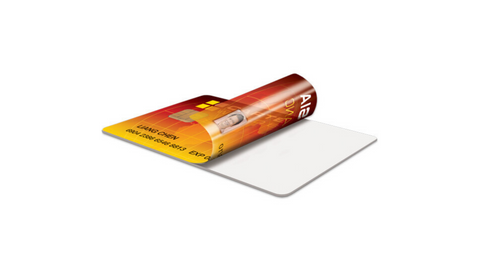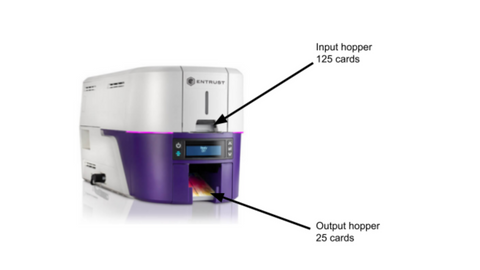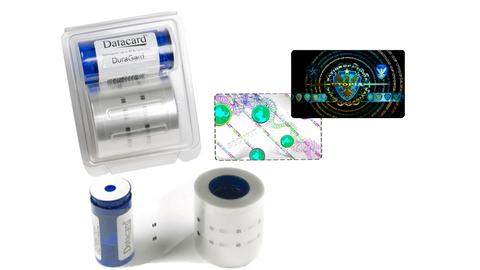
Expert guide to choosing the right ID card printer
With such a wide variety of card printers out there, selecting an ID card printer can be overwhelming.
This guide will help you choose the best ID card printer for your business's needs.
Below is a short table summary of what we speak about in the guide.
|
Printer type |
Budget |
|
Method |
No. of prints per hour |
Additional features |
Connectivity type |
|
DS1 |
Low |
Single-sided |
Direct to card printing |
660 monochrome print 175 colour print |
Magstripe & barcode |
USB |
|
DS2 |
Medium |
Single or dual-sided |
Direct to card printing |
800 monochrome print 140-225 colour print |
Encoding (magstripe, prox and smart card) |
USB & Ethernet |
|
DS3 |
High |
Single or dual-sided |
Direct to card printing |
1100 monochrome print 180-250 colour print |
Encoding (magstripe, prox and smart card) Lamination DuraGard Tactile impression |
USB, Ethernet & Wi-fi |
|
CR805 |
High |
Single and dual-sided |
Retransfer printing |
65-110 colour print |
Encoding (magstripe, prox and smart card) Tactile impression (added security) |
USB & Ethernet |
After reading this article, please fill in our quiz to know which card printer is best for you if you are still unsure. We will get back to you as soon as possible.
Step 1: Determine your budget
It is beneficial to have a budget in mind before choosing a printer as it can help weave out some of the printers that may be too expensive.
A complete ID card printer ranges from R10 000 to R60 000. There is a significant price gap.
Based on what your company uses the printers for, you’ll need to pay a specific price.
It’s essential to know what cards you will be printing—ensuring that you do not get a printer with unnecessary components.

Step 2: What cards are you printing?
There are generally four different types of ID Cards:
- Plain PVC card
- Mag-stripe
- Proximity
- Smart
Each type has different uses.
Plain PVC card

With this card, you will be printing basic information on your card.
- Name & surname
- ID number
- Photo
- Company name
- Company logo
However, there will be no technology embedded in the card. These are perfect for basic ID cards shown to your security officer.
You will need an entry-level card printer to print this card. Basic ID cards are perfectly compatible with the DS1 card printer.
This printer is excellent for printing:
- Visitor cards
- Basic ID cards
- Membership cards
Mag-stripe card

Where are mag-stripe cards used?
- Transportation ticketing
- Time and attendance tracking
- Access control
- Credit and debit card payments
- Hotel room keys
- Loyalty programs for grocery stores
- Library cards
These technology cards have Hi-co or Lo-co magnetic stripes. Hi-co is more secure and durable than Lo-co.
You can use medium size to entry-level card printer for these cards. Most of our printers offer a magnetic stripe encoding option without adding a considerable cost.
Our magnetic stripe encoding printers:
- DS1 card printer (you can upgrade to this option with an additional cost)
- DS2 card printer (no upgrade necessary. Included in the price)
- DS3 card printer (no upgrade)
Proximity cards

A proximity card or prox card, also known as a key card, is a contactless smart card that can read without inserting it into a reader device.
Because they do not require the user to swipe the cards, they can be left in a wallet and purse and still read by the reader. The card has an embedded metallic antenna coil which holds the encoded data.

They have more memory than mag-stripe cards and, therefore, can hold more data. The card frequency is at 12.56kHz, which can, unfortunately, be hacked or cloned easily.
Perfect for:
- Access control
- University or school access
- Library cards
- Contactless payment systems
- Public transport tickets
These cards are compatible with
Smart cards

Smart cards are an advanced contactless card system with better speed, frequency (13.56kHz) and storage than the proximity card.
Smart cards have an embedded chip where the technology can store more data. Smart cards have extra security and encryption technology that keeps your data information safe and secure from hackers.
However, the cost of the smart card is significantly higher; it is still the best route.
Perfect for:
- Access control for employees
- Contactless payment
- Government security
- Loyalty programs
- Transit cards
- Meal plans
Compatible with these printers:
A common issue that we have especially, when you add additional features onto your card, is that the chip may prevent printing. Our expert help can prevent these issues.
Specific industries for smart cards
- Mining (access control)
- Transport (ticketing services and loading money onto cards)
- Universities (access control & identity)
- High schools
- Hospitals (preventing unauthorised members from accessing essential places)
- Government
- Computer system companies
- Safety & security companies
If you fit into some of these industries, smart cards are the right solution for you.
Step 3: Single-sided or double-sided print

Single-sided printing means you have to flip the card to print on the other side manually.
Double-sided printing means that the machine automatically turns the card for you.
It’s far more time consuming with a single-sided printer than a double-sided one.
A double-sided printer usually adds another R3 000 to your printer cost.
Suppose you are unsure of purchasing a printer with double-sided capabilities. Purchase a printer that can upgrade if necessary.
Step 4: printing method
Direct-to-card printing

Most ID card printers use direct-to-card (DTC) printing. These printers infuse the colour from the printer ribbon onto the card using heat from the printhead.
They are never wet when the cards come out and do not smear like inkjet or laser printers. The colour covers the card on edge-to-edge printing but may sometimes leave a small white border around the card edge.

Above is what we mean when we talk about edge-to-edge printing. The colour covers the card even on the edges.
Retransfer printers

This higher-end printing technology produces crisper, high definition resolution, and accurate over-the-edge printing without any white borders.
Retransfer printers use both a printer ribbon and a transfer film to print. The card image prints onto the transfer film, and then the film fuses over the entire surface of the card.
Because the printhead never touches the card, it is ideal for cards that could damage the printhead. These include technology cards.
Technology cards are much thicker than basic ID cards and have a chip inside, damaging the printhead if not handled correctly.
The retransfer film also adds an extra layer of durability and protection that isn’t present on cards printed with direct-to-card printing.
However, retransfer printers are more expensive than direct-to-card printers, starting at about R64 000.
If your company requires higher quality prints but cannot afford the price of this card printer, then we suggest going through our factory. Therefore, a much more affordable solution.
Step 5: Number of prints
Knowing the volume of printing per month is significant in choosing the right card printer.
Small businesses can save money by buying a more affordable printer but will have to wait longer for their cards and spend more on cleaning supplies.
Medium to large companies may prefer to invest in a more expensive printer upfront to save on labour and supply costs.
Input and an output hopper

Input hoppers hold the blank cards before printing, while output hoppers hold the printed cards after printing.
Hoppers limit the maximum amount of cards you can print at a time. Smaller hoppers have to be refilled with cards more frequently, meaning that you have to stand over the printer to feed it. Larger hoppers save time and labour by allowing larger batch sizes of cards.
Print speed
A full-coloured printer can take 12-35 seconds per card, depending on which printer you use.
Businesses with high volume print requirements can save time and costs by selecting a faster printer. Companies with low to medium volume programs will be impacted less dramatically by printer speeds and should focus on other printer qualities.
Ribbons

Each ribbon has a set number of card prints that it can produce called the ribbon yield.
Printer ribbons usually yield between 250-500 cards, but some printers have high capacity ribbons available that can produce 500 -1500 card prints.
Longer ribbons need to be changed less often, saving time and labour and lowering print costs.
If your business has high volume card printing needs, make sure to use a more sizable ribbon.
Remember that you should also use a cleaning kit and run a printer cleaning cycle every time you change a ribbon.
Step 6: Additional security features: lamination & encoding
Lamination (clear or hologram)

Lamination increases your ID card's lifespan and durability. It is beneficial for cards in high impact environments, cards used outdoors, or swiped cards through a reader.
Laminates can be ordered with embedded holograms, adding an extra layer of security to prevent fraudulent duplication.
These holograms include:
- Logos
- Pillar icon
- Globe icon
- Bank icon
- Secure lock icon
- Secure globe icon
Most printers do not have lamination as an option; these are more advanced features and will cost more. Lamination usually adds R20 000 to the printer’s price, making it a high budget printer.
DuraGard

DuraGard is a technology that adds a hologram-like watermark over an ID card without requiring a lamination unit or any additional supplies.
These water-like holograms include
- Logo (for your company)
- Globe icon
- Pillar icon
- Bank icon
- Secure lock icon
- Secure globe icon
This extra layer of visual security helps prevent unauthorised ID card duplication. Still, it doesn’t add additional durability, unlike lamination.
DuraGard comes built-in to your printer and doesn’t add to the printer or supply cost per card.
Tactile impression

The tactile impression is an imprint visible on the card. The imprint is felt by rubbing your finger over the card. The impression can be placed on the back or front of the card with added security features.
By adding this extra security feature, ID cards offer more visual verification than a simple picture and name card.
Businesses are making more of an effort to secure and ensure the safety of their workers.
This extra security feature prevents:
- Card replication
- Tampering
- Counterfeiting
A unique design, pattern, or image is impressed by the card's laminate. This is an additional overlay that impresses a special design or pattern on the card.
The tactile impresser uses heat to create the impression and fuses the foil to the card.
Unique impression:
- Logo (for your company)
- Globe icon
- Pillar icon
- Bank icon
- Secure lock icon
- Secure globe icon
Based on your companies needs, we can create a specialised die for your company's logo or we can give you one of our dies stated above.
If you choose to get a specialised die, this will be more expensive to make but, we can quote you on this variable price.
These are great added features for:
- Government ID cards
- License department cards
- Hospital cards (high authority)
UV ink
Some printers can print cards using UV ink, only visible under a specialised light.
UV ink makes identifying cloned cards much more accessible. The UV ink is a part of select printer ribbons, so it’s worth making sure the printer you choose can use UV ribbons if you need it.
The DS3 is compatible with UV ribbons.
Watermarks
Printing a visible, secure watermark onto your ID cards is a fantastic way of immediately enhancing your cards’ security.
They are challenging to clone, and many manufacturers offer their own unique watermark security systems for printed cards.
These include:
- Globe icon
- Pillar icon
- Bank icon
- Secure lock icon
- Secure globe icon
You can have your specialised icon on your card, but this special die will cost a bit more.
The DS3 card printer is compatible with watermarks.
Encoding options
Different types of encoding technology:
- Barcodes
- Magnetic stripes
- Proximity cards
- Smart-card technologies
Where are they used?
- Access control
- Time and attendance tracking
- Membership
- Cashless payment.
Almost all printers have similar encoding options, so this requirement won’t usually impact deciding which printer is best.
Step 7: Connection type
Will you need to connect your printer to a single computer or a network so multiple computers can print to it?
- USB cables connect printers to a single computer and come standard with all printers.
- Ethernet connections are required to join the printer to a network. Ethernet comes standard with some printers but is not available on some entry-level printers.
- Wi-Fi is also an available option on printers and allows you to send print commands to your printer remotely.
Consider that if you use multiple computers to print ID cards, you will need to connect your printer over Wi-Fi.
Step 8: Warranty and technical support
Our ID card printers all come with manufacturer warranties of between two and three years.
Our dedicated in-house technical support team are also on hand to help you set up your printer. We have provided support videos for you to follow. These videos explain setting up your card printer from start to finish. Click on the playlist of the printer you are purchasing, and we will have all the videos for it.
Conclusion
You have reached the end of our guide. We hope we have answered some of your questions and given you some good feedback on which printer to choose.
After reading this article, please fill in our quiz to know which card printer is best for you if you are still unsure. We will get back to you as soon as possible.
Every business is different and unique. We can guide you to which printer suits your needs, but ultimately, you decide which printer is best.
Please get in touch with us for more information or issue a quote on our website.

